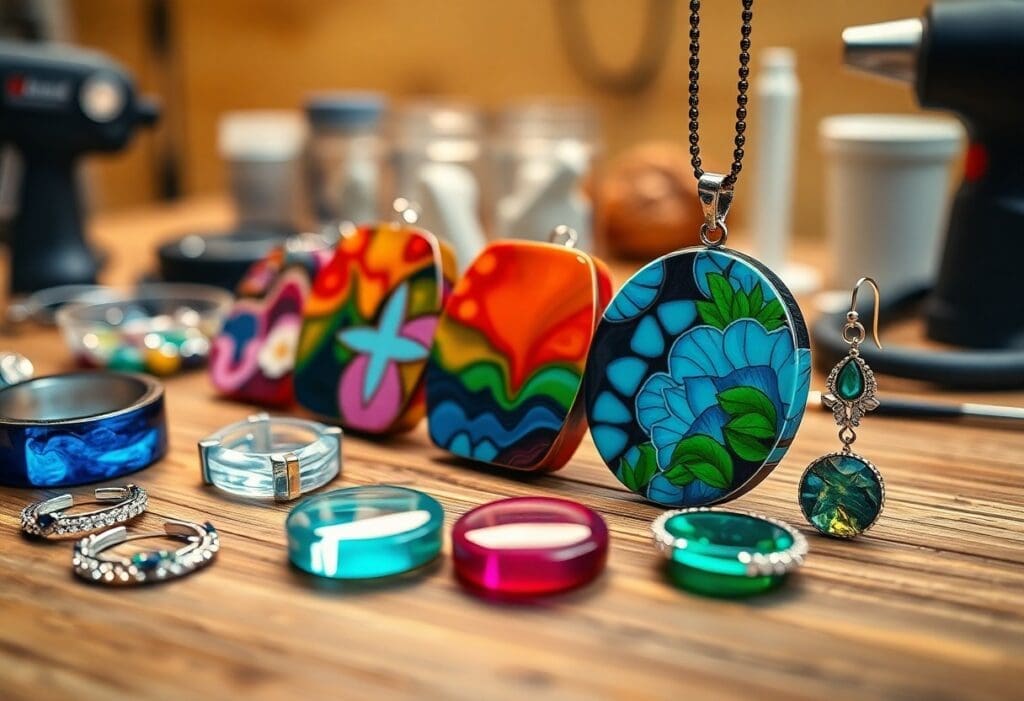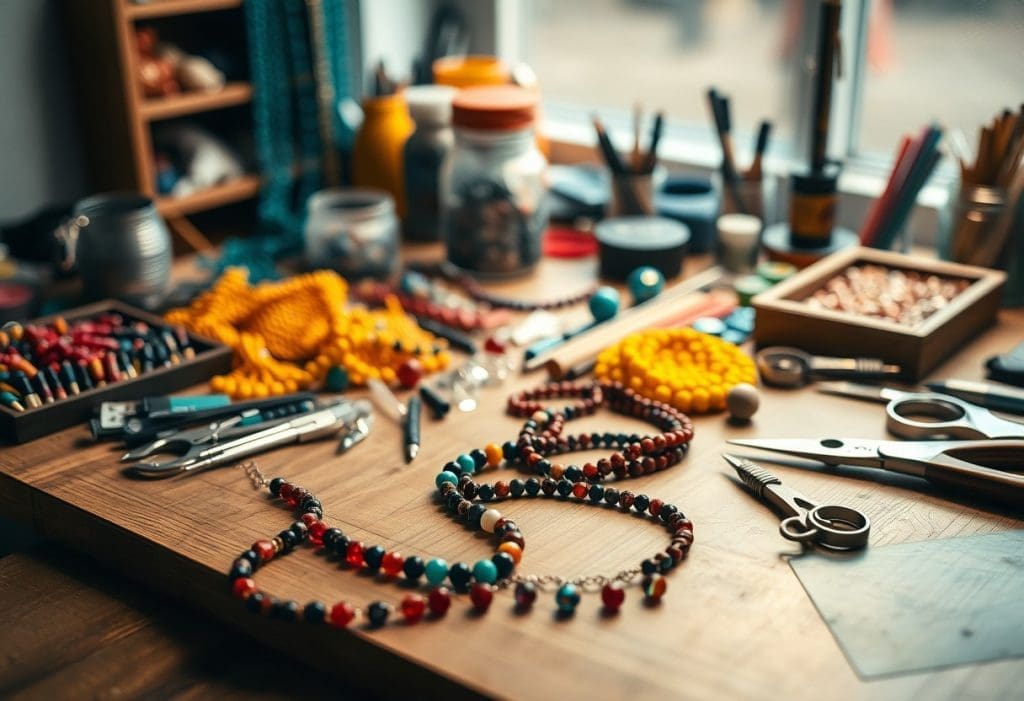There’s a captivating world waiting for you in resin art and jewelry making, where creativity meets craftsmanship.
This guide will introduce you to the imperative techniques and materials you need to examine this exciting hobby.
You’ll learn how to create stunning pieces that showcase your unique style, from colorful jewelry to intricate art projects.
Whether you’re a beginner or looking to refine your skills, you’ll find valuable insights that will inspire your artistic journey and help you unleash your inner creator.
The Allure of Resin: Unveiling Its Artistic Potential
The Unique Characteristics of Resin
Resin captivates artists with its versatility and transformative properties.
This synthetic material, primarily made from epoxy or polyurethane, boasts a glass-like finish that enhances the vibrancy of colors and embedded objects.
Its ability to cure into various forms allows you to craft anything from intricate jewelry pieces to large-scale art installations.
The smooth texture and clarity of resin create stunning visual effects, making your creations truly stand out.
The Growing Popularity and Cultural Impact
Resin art has experienced a remarkable surge in popularity over recent years, becoming a staple in contemporary art and DIY culture.
Social media platforms, particularly Instagram and Pinterest, showcase a multitude of resin projects, inspiring countless DIY enthusiasts.
This visually appealing medium has made it accessible for aspiring artists to break into the creative scene without traditional training, promoting a new wave of artistic expression.
The expanding interest in resin art is also reflected in the rise of online communities and marketplaces dedicated to showcasing and selling resin creations.
Artists around the globe are not only sharing their techniques but also forming collaborative networks, driving innovation and trends within the medium.
The combination of accessibility and creativity has elevated resin art to a form of personal expression, with many finding it a therapeutic outlet.
As artisans push boundaries and explore new possibilities, resin continues to reshape the landscape of modern art and craft.
Essential Materials: Crafting Your Toolkit
Understanding Different Types of Resin
Resin types vary significantly, each suited for different applications in art and jewelry making.
Epoxy resin is popular for its versatility and clear finish, while polyester resin is often used for larger projects due to its quicker curing time.
UV resin is perfect for small crafts, curing instantly under UV light.
Casting resin enables you to create thicker layers and intricate designs.
With each type, its own unique properties will influence your choice based on your specific project requirements.
- Epoxy Resin: Flexible, durable, and high-gloss finish.
- Polyester Resin: Fast curing and commonly used for larger items.
- UV Resin: Quick curing under UV light, ideal for small pieces.
- Casting Resin: Suitable for thick layers and original designs.
- Bubble-Free Resin: Specially designed to eliminate air bubbles.
Any resin type you choose will come with its own set of techniques and requirements.
When you explore these options, you can greatly enhance your creative expressions.
Must-Have Tools for Beginners
Your toolkit for resin art and jewelry making should include a selection of vital tools that make the crafting process smoother.
Start with mixing cups and stir sticks to blend your resin, a heat gun or torch to pop bubbles, and molds for shaping your creations.
An assortment of pigments, glitters, and inclusions will add unique touches to your projects.
Finally, a precision scale helps you measure resin accurately for consistent results.
Investing in quality tools early on sets the foundation for successful projects.
Mixing cups should ideally be graduated for easy measurements.
Meanwhile, stir sticks can be as simple as disposable wooden craft sticks.
A small butane torch works wonders for bubble removal, ensuring a flawless finish.
Flexible silicone molds define shapes in your pieces, and various pigments—such as alcohol inks or powdered dyes—allow you to achieve vibrant colors and effects.
Every tool you add contributes to refining your craft and realizing your creative vision.
Safety Gear and Best Practices
Always prioritize safety in resin art, especially since many resins include chemicals that can be harmful.
Wearing gloves protects your hands from irritation, and a mask filters out harmful fumes.
Be sure to work in a well-ventilated area so you can avoid inhaling any airborne particles.
Use safety goggles to protect your eyes from splashes or any accidents while mixing or pouring the resin.
One of the best practices in resin art is to set up a designated workspace with adequate ventilation.
This can mean opening windows or using a fan to circulate air while you work.
Keep your materials organized to minimize clutter and reduce the risk of spills, while also allowing you to focus on your creative process.
Always have a cleanup plan, including solvent for resin spills.
This is how you can keep safety in focus without dampening your artistic spirit.
Mastering the Techniques: From Pouring to Finishing
The Pouring Process: Step-by-Step Guide
Perfecting the pouring process is vital for creating flawless resin pieces. Follow this step-by-step guide to ensure success:
| Step | Description |
| 1 | Prepare your workspace, ensuring it is clean and dust-free. |
| 2 | Measure and mix the resin and hardener according to the manufacturer’s instructions. |
| 3 | Pour the resin mix slowly into your mold, avoiding bubbles. |
| 4 | Allow the resin to cure as per the recommended time. |
Designing Your Piece: Color, Embedding, and Effects
Diving into artistic creativity involves exploring colors, embedding objects, and enhancing effects in your resin art.
Consider using alcohol inks, mica powders, or even glitter to add vibrant hues and finishes to your pieces.
This is how you can transform common molds into unique masterpieces.
You can also embed objects such as dried flowers, charms, or beads into the resin mix for a personal touch.
Experiment with layering techniques to achieve depth and interest in your design.
Finishing Techniques: Sanding, Polishing, and Sealing
The finishing phase elevates your resin creation, ensuring a professional appearance.
Start sanding your piece with fine-grit sandpaper to remove imperfections left from the mold. Follow this with polishing to achieve a glossy finish.
Finally, seal your piece with a clear coat to enhance durability and shine, making your artwork not only beautiful but long-lasting.
Finishing techniques are where your work truly comes to life.
After sanding, use a polishing compound or buffing wheel for that pristine gleam, bringing out the color and depth in your resin.
I also recommend a resin gloss or spray sealant to seal it, providing a protective layer against scratches and yellowing.
The attention you give to these meticulous steps will reflect in the final presentation of your art, captivating everyone who sees it.
Transforming Vision into Reality: Designing Jewelry with Resin
Inspirational Design Ideas and Themes
Drawing inspiration from nature, personal experiences, or abstract concepts can ignite your creativity.
Consider themes like botanical elements, celestial motifs, or even cultural symbols.
Each design idea can reflect your unique style, adding an element of storytelling to your pieces.
For example, capturing the colors of sunset in a pendant or encasing dried flowers in resin can lead to stunning, conversation-starting jewelry that resonates with viewers.
Choosing the Right Molds and Shapes
Selecting the appropriate molds is a key factor in achieving the final shape and style of your resin jewelry.
Various shapes like circles, hearts, or geometric patterns can significantly influence the overall aesthetic.
Silicone molds provide versatility, allowing for easy removal and multiple uses.
Experiment with different sizes and forms.
This helps you find what resonates with your artistic vision.
Explore diverse mold options ranging from intricate designs to simpler forms.
Specialty molds might have added features like embedded textures or layers, enhancing the depth of your pieces.
Prioritize quality; opt for molds made from durable silicone.
This will ensure that your creations maintain their original shape without overwhelming effort.
By mixing various shapes and sizes, you can also create unique combinations, pushing the boundaries of your designs.
Creating Meaningful Pieces: Personal Stories and Symbolism
Incorporating personal stories or symbols into your jewelry not only enhances its appeal but also allows for deeper connections with the wearer.
Each piece can serve as a unique expression of your identity, beliefs, or milestones.
For instance, a specific color palette might represent a cherished memory, while incorporating a charm can symbolize a life-changing event.
Consider how certain colors or materials resonate with your experiences.
Perhaps you have fond memories tied to a specific flower. Or maybe a specific shape speaks to a transformative moment in your life.
By embedding these nuances into your designs, you create jewelry that carries more than just ornamental value; it becomes a piece of your narrative, cherished by those who wear it.
This personal attachment can enhance the significance of your work, capturing the essence of who you are or your journey through life.
Navigating Pitfalls: Common Mistakes and How to Avoid Them
Top Errors Made by Beginners and Their Solutions
One of the most common mistakes new resin artists make is not measuring the resin and hardener accurately.
This can lead to incomplete curing. To ensure a successful pour, always follow the manufacturer’s instructions for the correct ratio.
Another frequent error is using the wrong type of mold.
Silicone molds work best for resin projects, as they allow for easy release and preserve details.
Quality molds can save you time and frustration.
Beginners often rush the curing process by not allowing sufficient drying time. Be patient for the best results.
Troubleshooting Common Issues with Resin
Encountering problems with resin is part of the learning curve. Bubbles, sticky spots, or improper curing can be discouraging, but they are often fixable.
If you’re dealing with bubbles, using a heat gun or a torch can help pop them before the resin fully cures.
Sticky spots generally signify an incorrect resin-to-hardener ratio. Be sure to check your measurements and mix thoroughly.
If your piece remains tacky after curing, it may need additional layers of resin to seal it properly.
Each issue provides a valuable lesson for future projects.
For example, sticky spots can often be fixed by sanding the affected area and applying a new layer of resin, ensuring a smooth finish.
If bubbles persist, experimenting with different casting temperatures and slower pour rates can yield better results.
It’s also wise to keep your workspace dust-free, as particles can mar your final piece.
Every challenge faced presents the opportunity to refine your technique, ultimately leading to more polished and professional-looking work.
Pricing Your Art: The Economics of Resin Jewelry
Understanding Material and Labor Costs
To price your resin jewelry effectively, start by calculating material costs, including resin, pigments, molds, and hardware.
Factor in labor by determining how many hours you spend on each piece and setting a realistic hourly wage for your time.
For example, if you invest $5 in materials and spend 3 hours creating intricate earrings, pricing them under $30 may undervalue your effort.
You always want to be sure they cover both cost and time if you want to pull a profit.
Market Trends and Successful Pricing Strategies
Keeping an eye on market trends can guide your pricing strategy significantly.
Research similar resin jewelry items in various platforms and local markets to assess average pricing.
For instance, if similar items range from $20 to $60, consider where your pieces fit into that spectrum based on uniqueness and craftsmanship.
Additionally, offering a range of prices can cater to different customers while maintaining brand integrity.
By focusing on market trends, you can not only establish competitive pricing, but also understand the importance of presenting value.
Craftsmanship, originality, and product story all contribute to perceived worth.
If your pieces use high-quality materials or offer a sustainable angle, these aspects justify a higher price.
Seasonal themes and limited collections can also attract buyers willing to pay a premium.
It pays to be aware of what resonates with your audience and adjust your pricing structure accordingly.
Sharing Your Craft: Building an Audience and Brand
Leveraging Social Media for Exposure
Social media platforms like Instagram, Pinterest, and Facebook are invaluable tools for showcasing your resin art and jewelry.
Use high-quality images that highlight your craftsmanship and engage with your audience through stories, live videos, and even tutorials.
Aim to post consistently, and always use relevant hashtags.
These tactics can significantly increase your visibility, helping you connect with potential customers and fellow artists alike.
Creating an Online Store: Platforms and Best Practices
Establishing an online store is imperative for turning your artistic passion into a sustainable venture.
Start by choosing a platform that suits your needs, such as Etsy, Shopify, or WooCommerce (WordPress ecommerce plugin).
Consider the ease of use, fees, and integration with payment systems.
Maintain high-quality photos and detailed descriptions to ensure customers understand the uniqueness of your pieces.
Regularly updating your store will keep your customers engaged and informed about new offerings.
Researching various platforms is key to finding the right fit for your brand.
Etsy is perfect for crafters with a built-in audience. On the other hand, Shopify gives you greater control over your store’s design and branding.
Set your store apart by telling your story in an “About Me” section, sharing your creative journey and the inspiration behind your pieces.
Make use of effective SEO practices so potential buyers can easily discover your store while searching for unique resin art and jewelry.
Networking with Other Artists and Makers
Connecting with fellow artists can open doors to collaborations, sharing resources, and learning valuable techniques.
Attend local art fairs, workshops, and online forums to build relationships within the community. These activities can lead to increased visibility and potential customer referrals.
Engaging with other artists offers more than inspiration; it can enhance your skills and expand your creative horizons.
Join social media groups dedicated to resin art or local craft circles where you can exchange tips, participate in joint projects, and support each other’s work.
By building these relationships, you not only create a sense of community. You can also tap into wider audiences as you share each other’s crafts.
This collaborative spirit can lead to growth for both your brand and others in the network.
The Future of Resin Art: Trends and Innovations
Emerging Techniques and Technologies
Innovation is reshaping the resin art landscape, with techniques like 3D printing and UV resin applications gaining traction.
These methods allow for intricate designs and quicker curing times, enabling you to explore new dimensions in your artwork or jewelry.
Experiment with color shifting pigments and metallic powders. This can yield stunning results, pushing the boundaries of traditional resin art into exciting, uncharted territory.
Sustainable Practices in Resin Art
Sustainability is becoming increasingly important within the art community, including resin art.
Artists are seeking eco-friendly materials and methods that reduce waste and environmental impact while maintaining the beautiful quality of their creations.
As you shift towards sustainable practices, consider using bio-based resins. These resins are derived from renewable resources such as plant-based materials.
These alternatives not only decrease reliance on petrochemicals but also minimize harmful emissions during the curing process.
Additionally, many artists are adopting reusable molds and experimenting with upcycling materials in their projects.
This approach not only creates unique items but also speaks to a growing audience that values environmental responsibility in art.
By integrating these sustainable practices, you can contribute positively to the ecosystem while continuing to produce stunning and innovative resin pieces.
Final Words
By exploring into the world of resin art and jewelry making, you’re opening up a realm of creativity and personal expression for yourself.
With the right techniques and materials, you can transform simple resin into beautiful, unique pieces that reflect your style.
Embrace the learning process, experiment with colors and forms, and watch your artistic skills flourish.
You’ll not only gain a fulfilling hobby but also create one-of-a-kind items that can be treasured or gifted.
Enjoy your journey in resin art and jewelry making. Your creativity is limitless!



